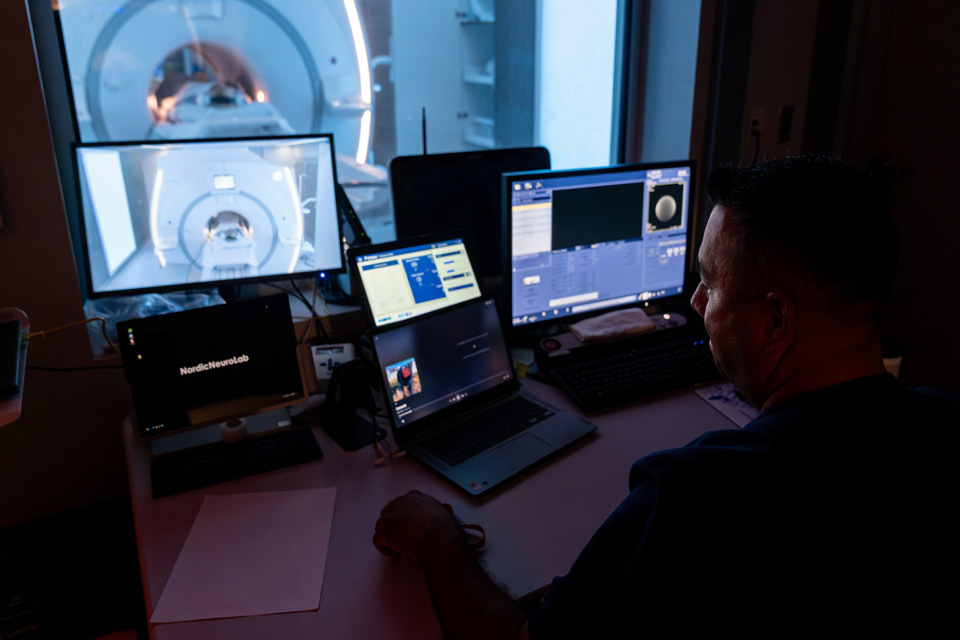
Hugo Gonzalez, an X-ray, CT, and MRI technologist with UT Health RGV, guides patients through the 3T MRI GE Caring Suite at the UTRGV Institute of Neuroscience in Rio Grande Valley, Texas, designed to ease patient stress during scans.
News Release | Community, Health

Hugo Gonzalez, an X-ray, CT, and MRI technologist with UT Health RGV, guides patients through the 3T MRI GE Caring Suite at the UTRGV Institute of Neuroscience in Rio Grande Valley, Texas, designed to ease patient stress during scans.
Thursday, October 31, 2024
Health
By Karen Villarreal
RIO GRANDE VALLEY, TEXAS – OCT. 31, 2024 – For those with claustrophobia or other phobias there is nothing scarier this Halloween than entering the chamber of dread, also known as the MRI machine.
The confinement in the small space and the haunting whirring and clicking sound of the machine are enough to trigger fear and anxiety in many, however Hugo Gonzalez, an X-ray, CT and MRI technologist with UT Health RGV, has a message for us nervous individuals, "Scans aren't scary," he said.
Gonzalez said UT Health RGV is proud to offer a 3T MRI GE Caring Suite at the UTRGV Institute of Neuroscience (IoN) specifically designed to ease patient stress as it captures high-quality, 3D images of their internal body structures.
At IoN, he guides patients through the procedures their doctors or clinical researchers have ordered. He explains the technology to ease some patients' anxiety about lying very still in machines that can look like something out of a science fiction movie.

RADIATION AND MAGNET MODALITIES
Gonzalez said the 3T MRI is one of three imaging modalities that can work together to give doctors and researchers a complete picture.
He explained that using different energy sources to produce images reveals various levels of depth within the body.
"X-rays produce a 2D image of one 'slice' of the body, while a computed tomography (CT) scan takes a series of pictures every few centimeters, giving a 3D result," he said. "The MRI captures the effect of a strong magnetic field on the body's protons to produce similar 3D images, while X-ray and CT scans use radiation."
"During a CT scan, iodine is injected through the vein to help highlight the organs and blood vessels. You lie on a table that slowly moves through a doughnut-shaped machine while an X-ray source rotates around you," Gonzalez said.
CT and X-ray scans are quicker than an MRI, but they sometimes reveal the need for an MRI for more detailed imaging. Gonzalez said the MRI allows for magnification and thinner "slices," providing more opportunities for a doctor to identify an issue.
"With the 3T magnet MRI, we can see everything from all sides, including muscle tears and fluid buildup. And there is no radiation," Gonzalez said. "That is a huge plus for some people who are concerned about their exposure."
Gonzalez said he had only a faint idea of what the future of diagnostic imaging held when he entered the field of radiology in 2006.
"It's come a long, long way in terms of better, clearer images," said Gonzalez, who grew up in McAllen and Elsa. "With an MRI, or magnetic resonance imaging, you're able to see a front-row picture of what's going on in the body."
A CALMER SCAN EXPERIENCE
Although imaging is critical for accurate diagnosis, Gonzalez said some patients’ phobias or sensitivities make an MRI scan a difficult experience.
"Some can't stand to be in the scanner very long due to PTSD or claustrophobia," he said.
However, he said the IoN's 3T MRI machine can carry out a scan faster than older MRI machines and is one of three with a magnet of that strength in the Rio Grande Valley.
"With a lower-strength magnet, you'd have to scan the patient for longer – about an hour," Gonzalez said. "And the GE Caring Suite is designed to maximize patient comfort."
The GE Caring Suite scanner has a wider bed, so patients don't feel as constricted. Mirrors inside the tube reflect a screen with soothing images of their choice, and speakers play the patient's music selection to distract from the noises the machine makes.
Cameras and microphones allow Gonzalez to monitor and communicate with the patient throughout the scan.
"You're never isolated and always able to look at something," he said. "That helps with anxiety."
The procedure is over in 30 to 40 minutes, and Gonzalez sends a CD with the images to the patient's doctor.
"Patients come out of it realizing that they didn't have to be so anxious," he said.
Gonzalez said he is happy to be helping patients in the Rio Grande Valley and easing their fears when they come face-to-face with the 3T MRI machine, providing them with valuable insight into their health.
To learn more about the Institute of Neuroscience at UTRGV, visit www.utrgv.edu/school-of-medicine/departments/institute-of-neuroscience/index.htm.
ABOUT UTRGV
The University of Texas Rio Grande Valley (UTRGV) was created by the Texas Legislature in 2013 as the first major public university of the 21st century in Texas. This transformative initiative provided the opportunity to expand educational opportunities in the Rio Grande Valley, including a new School of Medicine and a School of Podiatry, and made it possible for residents of the region to benefit from the Permanent University Fund – a public endowment contributing support to the University of Texas System and other institutions.
UTRGV has campuses and off-campus research and teaching sites throughout the Rio Grande Valley including Brownsville (formerly The University of Texas at Brownsville campus), Edinburg (formerly The University of Texas-Pan American campus), Harlingen, Weslaco, McAllen, Port Isabel, Rio Grande City and South Padre Island. UTRGV, a comprehensive academic institution, enrolled its first class in the fall of 2015; the School of Medicine welcomed its first class in the summer of 2016, and the School of Podiatric Medicine in the fall of 2022.